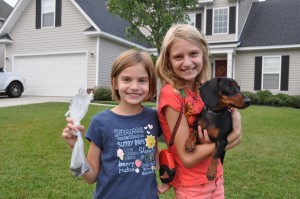The Pet Waste Project

Originally appears in the Spring 2012 issue
What do you do when your students become concerned about pet waste polluting the creek behind their school? Why, you let them solve the problem.
My fifth grade students had been actively learning about the interrelationships among abiotic and biotic factors within the local ecosystem and how air, water and soil can become polluted. To connect this learning to the local environment, students were introduced to water quality testing. About once a month, we hiked down to the creek behind the school and tested the water for pH, dissolved oxygen, phosphates, nitrates, and fecal coliform bacteria. They researched each of these indicators to better understand how they impacted water quality. After several positive tests for fecal coliform, students became concerned.
Pet waste often washes into storm drains, which usually empty into the nearest creek, stream, or lake. The problem is that pet waste can contain a variety of bacteria and parasites such as E. coli, fecal coliform, and roundworms. When pet waste is left on the side of the road or in a yard, the waste is picked up by rain or melting snow and carried to the nearest storm drain. This can make local waterways unsafe for swimming or drinking. Although pet waste may not be the largest or most dangerous pollutant in waterways, it can add up to a big problem in residential neighborhoods. One typical dog can excrete three quarters of a pound of waste per day or 274 pounds of waste per year! In 2007, the American Veterinary Medical Association indicated that, 37.2% of US households (72,114,000 in total) owned a dog, and the average number of dogs owned per household was 1.7.
To view the photo-rich magazine version, click here.
If you are not already a subscriber, please subscribe to read the full article
Cynthia Gardner is an assistant professor of education at Lander University in Greenwood, South Carolina, and a former 5th grade teacher.
Leave a Reply
You must be logged in to post a comment.










